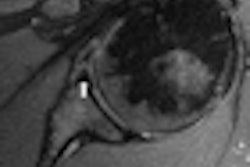Despite the rise of digital imaging, traditional physical tasks such as moving patients cause far more repetitive stress symptoms for radiologic technologists (RTs) than computer work, according to a new study published this month in the Journal of the American College of Radiology.
Researchers at Beth Israel Deaconess Medical Center in Boston explored the prevalence of repetitive stress symptoms among radiologic technologists in their department, and evaluated which factors contribute most to these symptoms (JACR, December 2010, Vol. 7:12, pp. 956-960).
Fully digital departments are associated with a high rate of repetitive stress symptoms and injuries among radiologists due to their heavy reliance on computer-related tasks. But the effect of this environment on technologists has not been studied, according to contributing author Deborah Levine, MD.
"We noticed in our department that radiologists had a lot of repetitive stress injuries," Levine told AuntMinnie.com. "So we realized that probably the whole department could use interventions."
Levine and colleagues administered a survey to 225 technologists. They gathered data on whether the technologists had repetitive stress symptoms -- such as pain, stiffness, soreness, or cramping in the extremities or the back or neck area -- and prior diagnoses of repetitive stress syndrome. Survey participants were also asked whether they spent more than two hours per day in an awkward posture, and which factors from a list contributed to most of their symptoms.
The team received 104 responses (for a response rate of 46%). Seventy-three survey participants, or 70%, reported repetitive stress symptoms, and 44 (42%) reported prior diagnoses of repetitive stress syndrome. Seventy-one (68%) of study participants reported spending more than two hours per day in an awkward posture.
As for the factors that contributed to repetitive stress symptoms, those related to imaging and equipment were more predominant than those related to computer workstations. The most common factors were:
- Patient transfer: 33%
- Ultrasound probes: 23%
- Heavy imaging equipment: 20%
- Nonergonomic chairs: 19%
- Lead aprons: 10%
It's clear that imaging technologists are not a homogenous bunch, Levine said: Each imaging modality brings its own repetitive stress issues. X-ray technologists have to deal with lead aprons necessary to protect patients, ultrasound technologists often scan patients in nonergonomic positions, and CT technologists are required to move patients on and off tables, according to Levine.
"We've discussed what we can do with training [to address the problem]," she said. "We've worked with physical therapy to teach ultrasound technologists how to scan more ergonomically, and with CT folks to teach them how to protect their backs when they're making patient transfers. But there's a certain amount of patient care activity you can't protect people from."
And the percentage of technologists working through pain is on the rise, according to Charlotte Henningsen, president of the Society of Diagnostic Medical Sonography (SDMS) in Plano, TX, and chair of the sonography department at Florida Hospital College of Health Sciences in Orlando.
"In 2000, a benchmark survey was conducted that found 80% of sonographers were scanning in pain," Henningsen told AuntMinnie.com. "In 2009, a study reported that the percentage had increased to 90%."
Although there's been increased education of technologists themselves and attention to the issue by equipment manufacturers, there has also been an increase in patient throughput, according to Henningsen.
"Sonographers are scanning more and more patients each day, without adequate rest periods," she said. "And patient obesity is trending upward, so that ultrasound requires additional pressure from the technologist to acquire diagnostic images. These two factors outweigh those measures being taken to decrease musculoskeletal injury."
Levine's group found that traditional aspects of technologists' daily work tasks, such as patient transfer and the use of imaging equipment, are perceived to contribute more to their symptoms than computer-related activities, which are a major factor for radiologists; therefore, the study results suggest that ergonomic interventions in radiology departments should be tailored differently for radiologists and RTs.
"Knowing repetitive stress injuries are an issue in the radiology department is the first step toward looking for solutions," Levine said. "It's crucial to the health of our workforce that we pay attention to this."
By Kate Madden Yee
AuntMinnie.com staff writer
December 16, 2010
Related Reading
Radiologists may be prone to work-related injuries, May 3, 2010
Ergonomic practices can decrease repetitive stress injuries, May 18, 2009
Wii remote, Baroque music can lighten the load in reading rooms, April 28, 2009
Lean management plays key role in new hospital design, March 8, 2009
PACS software tool boosts clinical follow-up, December 15, 2008
Copyright © 2010 AuntMinnie.com




















